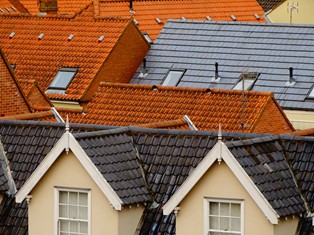Different types of roofing materials guide, Building roof types, Clay tiles advice
Types of Roofing Materials: Explained
22 Aug 2021
If it is time for a roof replacement of your home, there are probably many things you are wondering about. How much is it going to cost, what color do you want it, what the best materials are? There are various roof options out there that you can choose from. Of course, you will want to choose something that is best for both your home as well as your wallet.
When it comes to the roofing materials, the things you want to pay attention to are appearance, longevity, cost of the material, structural issues, and so on. Of course, the balance between these things will depend on your budget. Nevertheless, you can surely find a roofing material that will do the job well. To learn more about all the types of roofing materials you can get, read through the rest of this article.
Metal roofs
Metal roofs are one of the best options if you want a durable roof, resistant to various extreme weather conditions. People often opt for Metal Roofing if they live in regions with heavy snowfall or regions where there is a high probability of wildfires. These roofs are available in two types, shingles and panels. And the metals used to make them are copper, zinc, aluminum, as well as stainless steel.
Due to the use of these metals, these kinds of roofs are lightweight compared to other roofs, they look sleek and are also recyclable. They last longer than asphalt and wooden roofs and they offer solar reflectance. They look good on anything from cabins and bungalows to contemporary homes.
Clay tiles
Clay tiles are a great way to add texture and elegance to your roof. They are made from earthen clays which are molded into interlocking or rolled shapes and fired to harden. When left unglazed, they come in that characteristic reddish-orange color.
If glazed and fired, they form the ceramic roofing tiles. This type of roof is a good choice for people who live in hot climates or in climates where salt air is present, which is why you can often see them in coastal or desert regions. They are also quite long-lasting as they can last more than a century. The downside of these roofs is that they are quite heavy, so they must be installed by a professional.
Concrete tiles
If you want an alternative to clay tiles, you can opt for concrete tiles for your roof, as they offer similar advantages. The way concrete tiles are made is by molding them from a standard sand-mix concrete colored to the desired hues. These types of roofs are a great choice for you if you live in a region with lots of winds, as they are quite heavy as well. You can choose from a variety of profiles, even those with beautiful decorative coating.
Rolled roofing
Rolled roofing material is most often used on low-slope residential roofs and out-buildings such as sheds and shops. These roofs are made out of long rolls of asphalt-impregnated as well as mineral-impregnated material which is topped with small mineral granules. Because of the materials used, this type of roofing is quite inexpensive. It is a very fast and convenient way to cover a building with a sloped roof. However, the aesthetic of rolled roofing is not the best and it lasts, on average, around a decade before you need to replace it. So, if you are looking for a cheap, non-permanent option for your roof, opt for rolled roofing.
Membrane roof
Another relatively inexpensive roof type that can be used on low-pitch or flat roofs is a membrane roof. These roofs are made from different materials, including neoprene, PVC (polyvinyl chloride), polymer-modified bitumens, and EPDM (ethylene propylene diene monomer). The best choice among these is surely EPDM. Similar to asphalt roofing, EPDM is applied in large sheets which limit the places where water can infiltrate. Membrane roofs can last from twenty to thirty years if you maintain them properly.
Wood roofs
Wooden roofs represent one of the most aesthetically pleasing choices for a home. They are typically made from cedar or redwood. They are very attractive and they can give your home a very warm, cozy look. They are a good choice for people who live in places with a mild climate, with not too many extreme weather conditions. They should be avoided in areas with lots of moisture as well as in areas where there is a high risk of fires. So, if you live outside of places like this, and you want to create a luxurious rustic-looking home, choose this type of roofing.
Slate roof
A slate roof is the first choice of anyone who will only accept the finest, and rightfully so. Not only are these roofs one of the most beautiful ones to opt for, but they can last up to two hundred years. These roofs are made of thin sheets of real stone and are a good choice for any climate. However, with all of these benefits, slate roofs are quite expensive to have, heavy and they have to be installed by highly qualified installers.
Synthetic Slate Tile
Synthetic slate tiles are made from engineered polymers which are combined with rubber and recycled plastic. They are quite of a convincing stand-in for natural slate, to the point where they do not look any different when looked at from the ground. These tiles are a great choice for houses that cannot support natural slate, as it is very heavy. So, if you would like to have a less durable, but the equally pretty roof as you would with slate, opt for the synthetic slate tile roof.
Roofs are an important part of everyone’s home. Not only can they improve its aesthetic, but they can also serve an important role in protecting your house from extreme weather conditions. You can choose anything from metal and concrete roofs to wooden and slate roofs. It is up to you to choose which one fits best your needs as well as your wallet. Whichever type of roofing you opt for, make sure that you are buying the materials from a reliable seller and that the people installing your roof know what they are doing.
Comments on this Types of Roofing Materials: Explained article are welcome.
Roofing Articles
Roofing Posts
3 tips to prepare for your roof replacement
7 top benefits to consider on roof restoration
Building Articles
Residential Architecture
Comments / photos for the Different Types of Roofing Materials: Explained page welcome




